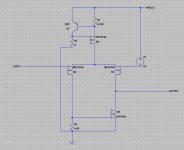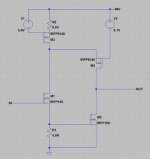it works superior in the simulations
Pavel, isn't there a connection missing in the schematic? Vout seems to hang in mid air?
Jan
I'm confused, do we now have two Pavel's or did he just change his handle on the site? When I see the comments something looks different now, am I just imagining that?
I like the Taylor cathode follower when using tubes. I have built a SRPP + W-C-F preamp with E88CC that I loved, except it had way to much gain for my needs.
The problem with all source/Cathode/Emitter followers is the low out-z.
I don't want to rely on global negative feedback for high out-z. I prefer high out-z from a intrinsic linear output stage. I like local source generation better.
regards,
Johannes
The problem with all source/Cathode/Emitter followers is the low out-z.
I don't want to rely on global negative feedback for high out-z. I prefer high out-z from a intrinsic linear output stage. I like local source generation better.
regards,
Johannes
Pavel, isn't there a connection missing in the schematic? Vout seems to hang in mid air?
Jan
no, it is the output tied between supplies. This is v to i amp with nfb. See asc file, it works OK.
it works OK.
I have not had time to study the LT-spice program any more. I had to make dinner.
I believe the voltages are a little off in the simulation. The output is not centred in the middle as the voltage-swing would clip unsymmetrical. There is more "wasted" voltage in the bottom part of the circuit due to the sensing fet and resistors setting idle current.
The fet sensing current through the amp is a logic gate IRL510. I have two volts Vgs setting the current at 2/1,5 = 1,333 amperes.
It sounds much better then my QSC RMX 1450 and my old Mission Cyrus amp. Much cleaner with much better separation of the instruments etc.. I run my large BIB with a B&C 10PS26bass driver and a small 3 inch Faital pro fullrange driver.
The bass is much better with my BIB then my MLTL. I guess it is the port-resonance of the MLTL is not suitable with a Qms of 6 in the Beyma 12P80Nd. The BIB has a much better loading over a much wider bandwidth then the ported MLTL, and the 10 inch driver has a Qms of 2,9.
regards,
Johannes

And the last variation of a current drive simple class A amp, based on the Triadtron concept from Tubecad.
It should have a decent linearity (i hope), high output impedance and sound really nice. I have not built it yet, but i hope i can test a simple crude version next week.
I am slowly learning to simulate circuits with LT-spice.
Thanks Pawel for showing me LT-Spice!
Cheers,
Johannes
my latest approach for current drive: http://www.diyaudio.com/forums/chip-amps/270956-lm1875-transconductance-amp.html#post4248804
Not solid state, but nonetheless somewhat related to the subject at hand:
Patent US7924091 - Class-D transconductance amplifier - Google Patents
Patent US7924091 - Class-D transconductance amplifier - Google Patents
POS,
Without reading the entire patent it sounds more like the difference between a CFA and VFA amplifier itself as applied to a class D amplifier. I don't see that they have then used that as a current driving amplifier to the speaker itself, that still remains outside the loop. Am I missing the point here?
Without reading the entire patent it sounds more like the difference between a CFA and VFA amplifier itself as applied to a class D amplifier. I don't see that they have then used that as a current driving amplifier to the speaker itself, that still remains outside the loop. Am I missing the point here?
I think that a paper by Esa Meriläinen belongs to this thread.
Download the new research report here:
Meriläinen, Esa: Comparative Measurements on Loudspeaker Distortion: Current vs. Voltage Control Archives of Acoustics. Vol. 42, No. 1, pp. 71–81 (2017).
Download the new research report here:
Meriläinen, Esa: Comparative Measurements on Loudspeaker Distortion: Current vs. Voltage Control Archives of Acoustics. Vol. 42, No. 1, pp. 71–81 (2017).
Hi!
I am great CC fan but for electrodynamic loudspeakers, my Magnepans QR1.5 play with 800Hz crossover peak when driving from V/I amp, no matter.
However I am not sure CC sound is superior vc VC due to lower THD but rather low speaker damping which "lets them play" (of course might be due to lower THD which are not amplified in gnfb loop, which is all about...).
I am still surprised that CC did not become popular, the people usualy start to blame modern speakers which are designed for VC, etc, before they make the listening test...
My experience with CC is,
that the sound improvement is so hudge,
that even undamped resonants from the speakers cannot spoil general feeling being amazed of the sound.
I am great CC fan but for electrodynamic loudspeakers, my Magnepans QR1.5 play with 800Hz crossover peak when driving from V/I amp, no matter.
However I am not sure CC sound is superior vc VC due to lower THD but rather low speaker damping which "lets them play" (of course might be due to lower THD which are not amplified in gnfb loop, which is all about...).
I am still surprised that CC did not become popular, the people usualy start to blame modern speakers which are designed for VC, etc, before they make the listening test...
My experience with CC is,
that the sound improvement is so hudge,
that even undamped resonants from the speakers cannot spoil general feeling being amazed of the sound.
6dB dip due to interference is less bad than 6dB dip due to resonance, and 1dB rise due to resonance is less bad than 1dB rise due to clang, say 10% harmonic distortion fundamental reset to 0dB.
I wonder if anybody have seen "nonswitching" or "autobias" or "economical A class" or "zeroswitching" transconductance amp?
I think that a paper by Esa Meriläinen belongs to this thread.
Download the new research report here:
Meriläinen, Esa: Comparative Measurements on Loudspeaker Distortion: Current vs. Voltage Control Archives of Acoustics. Vol. 42, No. 1, pp. 71–81 (2017).
Thanks Nikolas, that is nice article.
I use current drive and I never seem to not notice the improvements in sound, even with low cost speakers.
As far as branded speakers, the Bose acoustimass speakers come to life and just wow you with a current driver. With voltage amplifier, they seem dull and dead.
For DIYers, I recommend Pioneer 4" dual cone speakers with a current drive amplifier as satellites. They sound magical! Try it!!
As far as branded speakers, the Bose acoustimass speakers come to life and just wow you with a current driver. With voltage amplifier, they seem dull and dead.
For DIYers, I recommend Pioneer 4" dual cone speakers with a current drive amplifier as satellites. They sound magical! Try it!!
Can someone please post a link to a working current amp? Gainclone amp falls in this category? I tried some time ago a LM1875 schematic but couldn't make it stable.
Thanks!
Thanks!
Can someone please post a link to a working current amp? Gainclone amp falls in this category? I tried some time ago a LM1875 schematic but couldn't make it stable.
Thanks!
check if your connections were the same like here: http://www.diyaudio.com/forums/chip...onductance-current-amplifier.html#post3564061
you may also try TDA 2030, 2040, 2050 which seems to be more stable than 3875.
- Home
- Amplifiers
- Solid State
- Current drive for Loudspeakers
